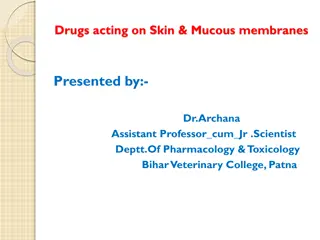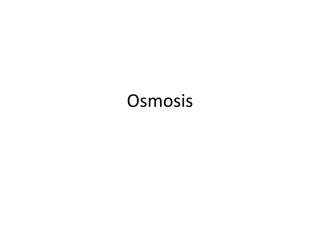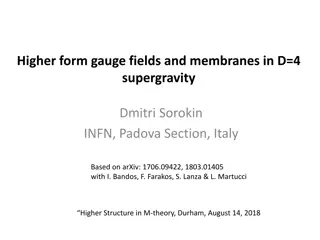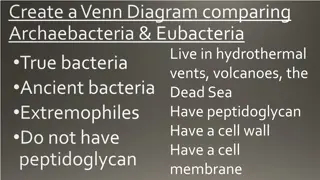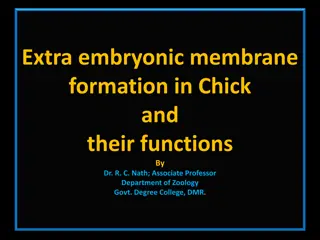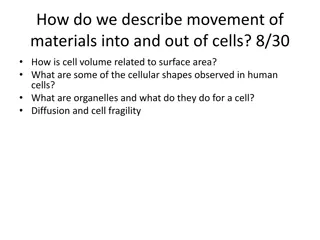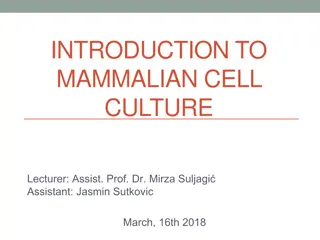Vi-CELL.BLU - Advanced Cell Counting Instrument
Vi-CELL.BLU is a cutting-edge cell counting instrument that offers faster analysis, increased resolution, and improved optical sensor technology for enhanced cell concentration and viability assessments. The device features a user-friendly interface, Trypan blue method for live cell detection, and a
1 views • 19 slides
Understanding Virus-Cell Interactions: Mechanisms and Consequences
Viruses interact with host cells in various ways, encoding genes that manipulate cell functions for their benefit. These interactions can range from benign to lethal outcomes. Factors influencing these interactions include viral factors, cellular responses, and the presence of virulence factors. Dif
0 views • 37 slides
Understanding Cell Reproduction and the Cell Cycle
Explore the process of cell reproduction, DNA structure, chromosomes, and the differences between prokaryotic and eukaryotic cell cycles. Learn about binary fission, mitosis, and cytokinesis in the context of cellular growth and division. Understand the significance of genes, DNA organization into c
5 views • 56 slides
Understanding Cell Viability Assays in Laboratory Testing
Cell viability assays play a crucial role in determining the health and status of cells, measuring their ability to survive and proliferate. These assays involve various techniques such as dye exclusion, colorimetric, fluorometric, luminometric, and flow cytometric assays. By assessing factors like
6 views • 16 slides
Understanding Lipids: Properties, Functions, and Types
Lipids are a diverse group of organic compounds that include fats, oils, hormones, and components of cell membranes. They are vital for energy storage, structural roles in cell membranes, hormone synthesis, and organ protection. Lipids can be classified into different types such as waxes, triglyceri
11 views • 14 slides
Understanding Cell Division: Functions and Stages
Explore the functions and stages of cell division through a comprehensive overview covering topics such as the importance of cell division in growth, repair, and reproduction, the stages of the cell cycle, and the comparison of different cell cycles. Engage with visual aids and concept maps to deepe
4 views • 43 slides
Bacterial Cell Structure and Composition Overview
Bacterial cells exhibit variations in size, typically ranging from 0.75 to 1.5 micrometers. The cell envelope, comprising glycocalyx, cell wall, and cell membrane, plays crucial roles in protection and cell function. The cell membrane, a thin barrier rich in phospholipids and proteins, is integral t
1 views • 28 slides
An Overview of Cell Biology: From Cytology to Modern Studies
Cell biology, also known as cytology, explores cells from various perspectives including physiological, developmental, and evolutionary aspects. Modern Cell Biology delves into the mechanisms of metabolism, heredity, and evolution at the molecular level, involving proteins, RNAs, and DNA. The compar
0 views • 13 slides
Understanding BD FACS Aria III for Efficient Cell Sorting
Learn about the BD FACS Aria III, a sterile cell sorter capable of analyzing up to 15 colors and sorting up to 4 populations simultaneously. Recommended sample concentrations, sorting procedures, and tube preparation guidelines are provided for efficient cell sorting. Discover important tips to ensu
1 views • 12 slides
Overview of Cell Culture Methods and Importance in Research
Introduction to the principles of cell culture, including tissue culture, organ culture, and cell culture methods. Discusses the advantages and disadvantages of each technique and highlights the need for cell culture in research for studying cellular behavior and large-scale production of cell mater
3 views • 45 slides
Comprehensive Overview of Treatment Membranes in Water Quality Risk Assessment Training
Comprehensive overview of treatment membranes in water quality risk assessment training, covering various membrane types, applications, and considerations. Membranes play a crucial role in removing a range of contaminants from water sources, with different membrane types suited for specific applicat
0 views • 9 slides
Mechanism of General Anaesthesia Theories: Lipid Solubility, Surface Tension, Microcrystal, Protein Binding
Mechanism of general anaesthesia involves theories focusing on the interaction of anaesthetics with cell membrane components like lipids and proteins. The Lipid Solubility theory emphasizes the importance of an anaesthetic's affinity and solubility in nerve cell membranes, while the Surface Tension
1 views • 10 slides
Understanding the Gibbs-Donnan Effect in Biological Systems
The Gibbs-Donnan Effect, named after physicists Gibbs and Donnan, explains the selective permeability of membranes to ions, leading to the establishment of Donnan potential. This phenomenon affects the distribution of ions and proteins across cell membranes, influencing processes like osmosis and io
0 views • 27 slides
Overview of Bacterial Morphology and Cell Structure
This article discusses the morphology of both Gram-positive and Gram-negative bacteria, highlighting examples of different arrangements and shapes. It also explores the structure and functions of bacterial cell walls, emphasizing the role of teichoic acids in Gram-positive cell walls. Additionally,
1 views • 38 slides
Cell Structure and Function: A Comprehensive Overview
Delve into the world of cells, exploring the distinct features of animal and plant cells, the differences between prokaryotic and eukaryotic cells, the significance of organelles, and the fascinating processes such as stem cell differentiation and cell adaptation. Discover how substances move across
0 views • 5 slides
Overview of Drugs Acting on Skin & Mucous Membranes
This presentation discusses different classes of drugs that act on the skin and mucous membranes, including emollients, demulcents, adsorbents, protectives, astringents, counterirritants, keratolytics, and skin disinfectants. Emollients soften and moisturize the skin, demulcents soothe irritation in
3 views • 10 slides
Understanding Bacterial Cell Structure and Function
Bacteria display unique cellular structures and functions that differ from eukaryotic cells. They have a simple structure with a plasma membrane but lack complex internal membrane systems. The cytoplasm contains inclusion bodies, ribosomes, and genetic material in the nucleoid. Bacteria can be categ
4 views • 21 slides
Regulation of the Cell Cycle: A Comprehensive Overview
Variation in cell cycle length in humans, controlled by internal and external mechanisms, with special proteins and checkpoint systems ensuring proper progression. External events trigger initiation and inhibition of cell division, while internal checkpoints maintain genetic integrity and chromosome
4 views • 14 slides
Understanding Osmosis and Cell Membrane Transport
Osmosis is the process of water molecules diffusing across a semi-permeable membrane, crucial for maintaining cell function. It involves the movement of water from areas of high concentration to low concentration until equilibrium is reached. Special proteins called aquaporins facilitate water trans
1 views • 24 slides
Understanding the Cell Cycle and Mitosis Process
The cell cycle consists of two main periods: Interphase and Mitosis. During Interphase, the cell prepares for division by growing in size and copying chromosomes. Mitosis, the division of the nucleus, results in the formation of two daughter cells with identical chromosome copies. Centrioles and cen
0 views • 26 slides
Understanding Cell Division: Processes and Types
Cell division is a vital process in living cells for growth and reproduction. This article explores the basics of cell division, including the cell cycle, types of cell division (such as mitosis and meiosis), and the initiation of cell division. It also covers key phases like interphase and provides
0 views • 20 slides
Overview of Cell Division in Prokaryotes and Eukaryotic Cells
Cell division plays a crucial role in the growth and reproduction of all organisms. In prokaryotic cells, binary fission is the primary mode of division, while eukaryotic cells undergo a more complex process involving cell growth, DNA replication, chromosome distribution, and cytokinesis. The cell c
0 views • 10 slides
Higher-Form Gauge Fields and Membranes in D=4 Supergravity
This study focuses on higher-form gauge fields and membranes in D=4 supergravity, exploring their role in cosmological constant generation and membrane nucleation. The dynamics of three-form gauge fields, their coupling to gravity and membranes, and implications for cosmological models and supersymm
0 views • 17 slides
Comparison of Archaebacteria & Eubacteria Venn Diagram
Archaebacteria and Eubacteria are two types of bacteria with distinct characteristics. Archaebacteria are ancient bacteria that are extremophiles, living in harsh environments like hydrothermal vents and volcanoes, lacking peptidoglycan. On the other hand, Eubacteria are true bacteria with peptidogl
0 views • 60 slides
Understanding Ion Channels in Cell Communication
Ion channels play a crucial role in cell communication by allowing ions to pass through cell membranes, controlling various cellular functions. Their high transport rate and electrochemical gradient differentiate them from other ion transporter proteins. Ion channels have diverse biological roles, i
0 views • 26 slides
Extra Embryonic Membrane Formation in Chick and Their Functions
The development of extra embryonic membranes in chick embryos plays a crucial role in their growth and protection. These membranes, including the amnion and chorion, serve various functions such as providing protection, facilitating gas exchange, and supporting the formation of the placenta. Underst
0 views • 20 slides
Understanding Active Transport of Molecules: Driven by ATP Hydrolysis
Active transport, fueled by ATP hydrolysis, facilitates the movement of molecules against their concentration gradients, essential for processes like ion pumping across membranes. The Na+-K+ pump, a prime example, utilizes ATP to transport Na+ and K+ ions across cellular membranes, maintaining impor
0 views • 23 slides
Explore the World of Developmental and Cell Biology
Developmental biology, stemming from embryology, investigates how organisms evolve from a zygote. It merges various fields like genetics, cell biology, and cancer biology. Cell biology focuses on cell properties and behaviors, using tools like genomics and microscopy. Research areas include cancer c
0 views • 8 slides
Understanding the Structure and Function of Cell Membranes in Biology
Explore the intricate details of cell membranes, focusing on the phospholipid bilayer structure, protein interactions, selective permeability, and various transport mechanisms. Discover how membranes regulate the entry and exit of substances, aid in metabolism, and compartmentalize organelles for ef
0 views • 20 slides
Understanding Osmosis in Cell Membranes
This quiz explores the concept of osmosis in cell membranes, focusing on the movement of water into outermost cells of roots by osmosis and its implications on cell sap. It covers topics such as active transport, diffusion, pressure in cell contents, and the role of water movement in maintaining the
0 views • 50 slides
Role of Cell Cycle in Nanoparticle Uptake and Dilution in Cell Population
The cell cycle plays a crucial role in the cellular uptake and dilution of nanoparticles within a cell population. This process involves different phases such as G1, S, G2, and M, each with specific functions related to cell growth, DNA synthesis, protein synthesis, and cell division. Understanding
0 views • 20 slides
Understanding Biomembranes: Composition, Structure, and Functions
Biomembranes, specifically the plasma membrane, play a crucial role in cell function by separating and protecting the cell, facilitating communication with the environment, and regulating transport processes. Composed of lipids, proteins, and carbohydrates, membranes have a fluid mosaic structure wi
0 views • 13 slides
Exploring Cell Structure and Function in Developmental Biology
Discover the intricate world of cell structure and function in the context of developmental biology. Delve into the inner workings of organelles, their functions, and how they contribute to cellular activities. Engage in interactive activities like building cell models and playing Cell Detective to
0 views • 14 slides
Understanding Cellular Transport and Concentration in Biology
Explore the movement of materials into and out of cells, the relationship between cell volume and surface area, various cellular shapes observed in human cells, the functions of organelles, diffusion, cell fragility, units of concentration measurement, regulation of movement across plasma membranes,
0 views • 20 slides
Understanding Cell Cycle Control in Biology
Maintaining control of the cell cycle is crucial to producing healthy daughter cells and preventing mutations that can lead to degenerative diseases like Parkinson's or cancer. Cell cycle checkpoints at G1, G2, and Metaphase ensure the cell meets specific requirements before progressing to the next
0 views • 11 slides
Understanding Cell Structure and Function
Explore the intricate world of cell biology through this comprehensive guide covering the definition of a cell, the characteristics of animal cells, the role of the nucleus, ribosomes, cell structure, organelles, cell membrane, and cell wall. Discover the fascinating details of eukaryotic cells and
0 views • 61 slides
Understanding the Functions of Cell Organelles
Explore the vital functions of different cell organelles such as the cell membrane, nucleus, endoplasmic reticulum, lysosomes, Golgi apparatus, mitochondria, cytoplasm, ribosomes, vacuole, cell wall, chloroplasts, and chlorophyll in a cell. Learn how each organelle plays a unique role in maintaining
0 views • 38 slides
Basics of Mammalian Cell Culture
Mammalian cell culture involves the removal of cells from an organism for growth in a controlled environment. Primary cell cultures can be sub-cultured, leading to the generation of cell lines. Sub-culturing involves transferring cells to fresh growth media for further growth. Different methods and
0 views • 29 slides
Understanding Animal Tissue Culture and Cell Line Production
Animal tissue culture involves growing tissues separate from the animal in a laboratory setting. To achieve exponential cell growth, cells are converted into immortal cell lines. The production of a cell line involves steps like breaking cell adhesion, incubation, and transferring cells to fresh med
0 views • 22 slides
Understanding Sterilization and Disinfection Methods
Sterilization involves killing all microorganisms, including bacterial spores, using physical, chemical, and mechanical methods. Disinfection, on the other hand, focuses on removing microorganisms using disinfectants. Chemical methods like antiseptics and disinfectants play a crucial role in ensurin
0 views • 18 slides















